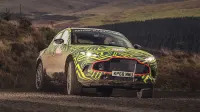Aston Martin working on an inline-six to replace Mercedes-sourced V8?

The English outlet says the deal Aston Martin signed with Mercedes-AMG was a stopgap deal while Aston Martin worked on proprietary engines. The report says the inline-six developed in Gaydon would eventually replace the 4.0-liter twin-turbo V8 currently powering the DB11 and Vantage.
If this purported inline-six were augmented with electrification, perhaps developed with help from the electric Rapid E program, it could make more sense of Becker’s first, misconstrued comments. At the time, Becker said the Mercedes hybridized engine “could fit with the brand in the future.” Taken generally, he could have meant an Aston Martin version of the German engine.
The certainty is that there’s a six-cylinder coming for larger-volume series production models, yet the reports and denials put competing rumors and powerplants in play. Aston Martin installs a 5.2-liter V12 in the DBS Superleggera, and Autocar suspects an inline-six could be derived from that engine. The automaker already has a six-cylinder in development, though, that being the turbocharged hybrid V6 said to be headed to the Ferrari- and McLaren-fighting Valhalla. Creating two new six-cylinder engines in different formats seems an odd choice for a tiny manufacturer.
What about the rumors that say the DBX crossover could get a six-cylinder? In July, when Motoring asked chief creative officer Marek Reichman about it, he said the DBX “could [use a Mercedes-sourced six-cylinder], because that would be a pretty good engine and combination. Potentially.” Autocar suggests, however, that the DBX will be first in line for the in-house inline engine.
Aston Martin has a storied history with the inline-six, all of them with links to other automakers. The legendary inline-six in the original DB cars of the mid-20th century were originally drawn up by Walter Owen Bentley – yes, that W.O. Bentley – for Lagonda automobiles. David Brown liked Lagonda and the 2.6-liter straight-six so much that he bought the company and used the motor in the Aston Martin DB2. The 1997 DB7 restored an inline-six to the company’s lineup for a couple of years, but that began life as the aluminum block from the Jaguar 3.2-liter AJ6 motor.
No matter what nor where the sixer comes from, once Aston Martin sells more than 10,000 units per year, the company will be bound to stricter emissions standards necessitating smaller engines. If Mercedes gets the nod and the V8 goes away, this might not happen until AMG ups its three-liters’ output. We’d be surprised if Vantage buyers would trade two cylinders and 73 hp for better emissions.
Related Video:




